Pronunciation
ran-IT-ih-deen - Pronunciation guide
Brand Names
- Zantac®
Description
 Ranitidine is an ulcer medication effective in both people and horses. As an H-2 blocker, it reduces acid production.
Ranitidine is an ulcer medication effective in both people and horses. As an H-2 blocker, it reduces acid production.
Usage
Ranitidine is used to treat gastro-duodenal ulcers in horses. The first step in treatment of ulcers in horses is the removal of stressful conditions and discontinuation of any anti-inflammatory medications. Veterinarians often recommend a combination of medications and a treatment period of at least three to four weeks.
Dosage and Administration
 Ranitidine Ranitidine |
||||
|---|---|---|---|---|
| Method | Dosage (click row for calculator) |
Concentration | Period | Duration |
| Oral | 6.6 mg/kg | 300 mg/tablet | 3 times daily | NA |
| Intravenous injection | 1-2 mg/kg | 25 mg/ml | 3 times daily | NA |
Notes:
|
||||
Side Effects
Ranitidine has been shown to have a wide margin of safety in laboratory animals.
Precautions
Ranitidine should be used with caution or at a reduced dose in horses with liver or kidney problems.
Ranitidine is not FDA approved for use with horses, but is commonly used and considered accepted practice. U. S. federal law restricts these drugs to use by or on the lawful written or oral order of a licensed veterinarian.
Ranitidine is forbidden in any drug-free competition. It is important to check with a knowledgeable veterinarian and the individual regulatory group.
Interactions
Histamine H2 receptor antagonists may affect blood clotting in animals on warfarin.
Some veterinarians recommend separating oral doses of ranitidine from antacids, metoclopramide, and sucralfate.
Overdose
No information was found regarding overdose of ranitidine in horses or other animals.
Images
 Ranitidine Oral Powder
Ranitidine Oral Powder
 Ranitidine Tablets
Ranitidine Tablets
Literature
